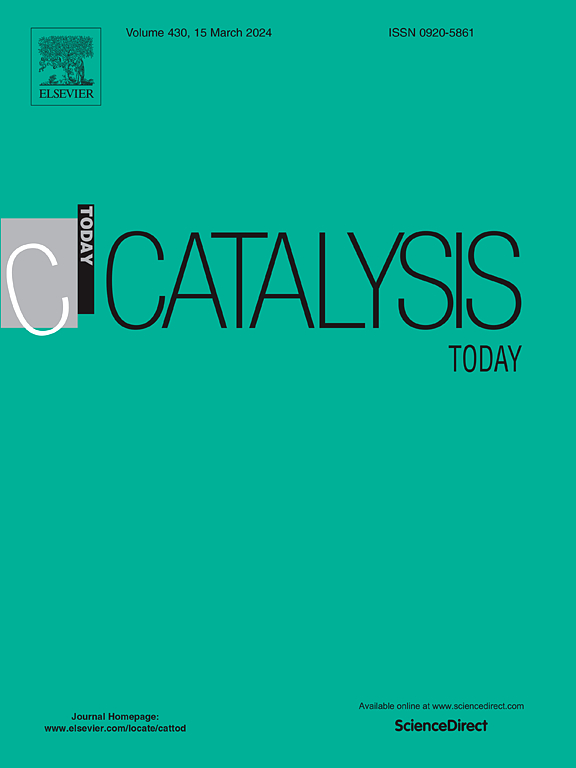利用新型介观结构光反应器合成有价有机物的无金属氮化碳聚合物薄膜
IF 5.2
2区 化学
Q1 CHEMISTRY, APPLIED
引用次数: 0
摘要
固定化光催化系统可以减少光催化剂回收和目标分子提纯的下游装置,从而为实现更可持续的化学工艺做出巨大贡献。另一方面,众所周知,与泥浆相比,这种光催化系统通常具有更高的传质阻力,因此动力学速度较慢。此外,这对使用生态友好型条件进行化学合成的限制更大,光催化材料与最佳反应器设计的结合对工艺效率起着至关重要的作用。在这项工作中,我们使用了一种微介质结构光反应器来克服这些限制,利用紧凑型 LED 系统为单位反应体积提供了较大的表面积,并在整个反应器中实现了更高的照明均匀性。通过将不同量的无金属光催化剂(氮化石墨碳)与可生物降解的聚合物基质(海藻酸钠)相结合,开发出了几种光催化薄膜。在合成芳香醛(茴香醛、甲苯醛、苯甲醛、香草醛和胡椒醛)的过程中,对催化性能进行了评估,这些芳香醛是由相应的茴香醇、甲苯醇、苯甲醇、香草醇和胡椒醇经光催化氧化而成。所有实验均在温和的操作条件下进行,以水为溶剂,室温、常压和自然 pH 值。最高产率依次为:茴香醛;甲苯醛;胡椒醛;苯甲醛;香兰素。该研究提出了一种低碳足迹、低能耗的光催化有机合成新方法。此外,这项工作所提供的结果为开发可持续光催化有机工艺的连续操作模式打开了一扇新窗口。本文章由计算机程序翻译,如有差异,请以英文原文为准。
Metal-free carbon nitride polymeric films for the synthesis of valuable organics using a novel mesostructured photoreactor
Immobilised photocatalytic systems can strongly contribute to attaining more sustainable chemical processes, reducing downstream units for photocatalyst recovery and purification of the target molecules. On the other hand, it is known that this kind of photocatalytic system usually presents higher mass transfer resistance when compared with slurries and, consequently, slower kinetics. Besides, this can be even more limited for chemical synthesis using eco-friendly conditions, where combining the photocatalytic material with the best reactor design plays a fundamental role in the process efficiency. In this work, a micro-meso structured photoreactor was used to overcome these limitations, providing a large surface area per reaction volume and a higher illumination homogeneity through the entire reactor using a compact LED system. Several photocatalytic films were developed, combining different amounts of a metal-free photocatalyst (graphitic carbon nitride) with a biodegradable polymer matrix (sodium alginate). The catalytic performance was evaluated in the synthesis of aromatic aldehydes (anisaldehyde, tolualdehyde, benzaldehyde, vanillin, and piperonal from the photocatalytic oxidation of the corresponding, anisyl-, toluyl-, benzyl-, vanillyl- and piperonyl alcohols. All experimental runs were carried out under mild operation conditions, using water as solvent, room temperature and atmospheric pressure, and natural pH. The maximum performance in terms of yield was attained in the following order: anisaldehyde > tolualdehyde > piperonal > benzaldehyde > vanillin. A novel approach for photocatalytic organic synthesis with a low carbon footprint and reduced energy requirements is proposed. Moreover, the results provided in this work open a new window for the development of sustainable photocatalytic organic processes in continuous mode operation.
求助全文
通过发布文献求助,成功后即可免费获取论文全文。
去求助
来源期刊

Catalysis Today
化学-工程:化工
CiteScore
11.50
自引率
3.80%
发文量
573
审稿时长
2.9 months
期刊介绍:
Catalysis Today focuses on the rapid publication of original invited papers devoted to currently important topics in catalysis and related subjects. The journal only publishes special issues (Proposing a Catalysis Today Special Issue), each of which is supervised by Guest Editors who recruit individual papers and oversee the peer review process. Catalysis Today offers researchers in the field of catalysis in-depth overviews of topical issues.
Both fundamental and applied aspects of catalysis are covered. Subjects such as catalysis of immobilized organometallic and biocatalytic systems are welcome. Subjects related to catalysis such as experimental techniques, adsorption, process technology, synthesis, in situ characterization, computational, theoretical modeling, imaging and others are included if there is a clear relationship to catalysis.
 求助内容:
求助内容: 应助结果提醒方式:
应助结果提醒方式:


